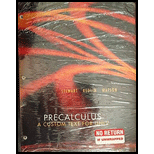
Concept explainers
Mixture Problem A merchant blends tea that sells for $3.00 an ounce with tea that sells for $2.75 an ounce to produce 80 oz of a mixture that sells for S2.90 an ounce. How many ounces of each type of tea does the merchant use in the blend?
To find: The quantity of each type of tea merchant use to blend.
Answer to Problem 60E
The merchant blend 48 oz of $3 tea with 32 oz of $2.75 tea.
Explanation of Solution
Given:
The merchant blend a tea of cost $3 and other tea of cost $2.75 to produce 80 oz mixture that sells for $2.90 an ounce.
Calculation:
Let the quantity of $3 tea be x.
Tabulate the given information into the language of algebra.
| In words | In Algebra |
| Quantity of $3 tea | x |
| Quantity of $2.75 tea |
|
| Quantity of mixture |
|
Model the equation for the above information.
Simplify the above equation for x,
The quantity of $3 tea is 48 oz. Quantity of $2.75 tea
Thus, the merchant blend 48 oz of $3 tea with 32 oz of $2.75 tea.
Chapter 1 Solutions
Precalculus - A Custom Text for UNLV
- Find the area of the shaded region. (a) 5- y 3 2- (1,4) (5,0) 1 3 4 5 6 (b) 3 y 2 Decide whether the problem can be solved using precalculus, or whether calculus is required. If the problem can be solved using precalculus, solve it. If the problem seems to require calculus, use a graphical or numerical approach to estimate the solution. STEP 1: Consider the figure in part (a). Since this region is simply a triangle, you may use precalculus methods to solve this part of the problem. First determine the height of the triangle and the length of the triangle's base. height 4 units units base 5 STEP 2: Compute the area of the triangle by employing a formula from precalculus, thus finding the area of the shaded region in part (a). 10 square units STEP 3: Consider the figure in part (b). Since this region is defined by a complicated curve, the problem seems to require calculus. Find an approximation of the shaded region by using a graphical approach. (Hint: Treat the shaded regi as…arrow_forwardSolve this differential equation: dy 0.05y(900 - y) dt y(0) = 2 y(t) =arrow_forwardSuppose that you are holding your toy submarine under the water. You release it and it begins to ascend. The graph models the depth of the submarine as a function of time. What is the domain and range of the function in the graph? 1- t (time) 1 2 4/5 6 7 8 -2 -3 456700 -4 -5 -6 -7 d (depth) -8 D: 00 t≤ R:arrow_forward0 5 -1 2 1 N = 1 to x = 3 Based on the graph above, estimate to one decimal place the average rate of change from x =arrow_forwardComplete the description of the piecewise function graphed below. Use interval notation to indicate the intervals. -7 -6 -5 -4 30 6 5 4 3 0 2 1 -1 5 6 + -2 -3 -5 456 -6 - { 1 if x Є f(x) = { 1 if x Є { 3 if x Єarrow_forwardComplete the description of the piecewise function graphed below. 6 5 -7-6-5-4-3-2-1 2 3 5 6 -1 -2 -3 -4 -5 { f(x) = { { -6 if -6x-2 if -2< x <1 if 1 < x <6arrow_forwardLet F = V where (x, y, z) x2 1 + sin² 2 +z2 and let A be the line integral of F along the curve x = tcost, y = t sint, z=t, starting on the plane z = 6.14 and ending on the plane z = 4.30. Then sin(3A) is -0.598 -0.649 0.767 0.278 0.502 0.010 -0.548 0.960arrow_forwardLet C be the intersection of the cylinder x² + y² = 2.95 with the plane z = 1.13x, with the clockwise orientation, as viewed from above. Then the value of cos (₤23 COS 2 y dx xdy+3 z dzis 3 z dz) is 0.131 -0.108 -0.891 -0.663 -0.428 0.561 -0.332 -0.387arrow_forward2 x² + 47 The partial fraction decomposition of f(x) g(x) can be written in the form of + x3 + 4x2 2 C I where f(x) = g(x) h(x) = h(x) + x +4arrow_forwardThe partial fraction decomposition of f(x) 4x 7 g(x) + where 3x4 f(x) = g(x) = - 52 –10 12x237x+28 can be written in the form ofarrow_forward1. Sketch the following piecewise function on the graph. (5 points) x<-1 3 x² -1≤ x ≤2 f(x) = = 1 ४ | N 2 x ≥ 2 -4- 3 2 -1- -4 -3 -2 -1 0 1 -1- --2- -3- -4- -N 2 3 4arrow_forward2. Let f(x) = 2x² + 6. Find and completely simplify the rate of change on the interval [3,3+h]. (5 points)arrow_forwardarrow_back_iosSEE MORE QUESTIONSarrow_forward_ios
 Calculus: Early TranscendentalsCalculusISBN:9781285741550Author:James StewartPublisher:Cengage Learning
Calculus: Early TranscendentalsCalculusISBN:9781285741550Author:James StewartPublisher:Cengage Learning Thomas' Calculus (14th Edition)CalculusISBN:9780134438986Author:Joel R. Hass, Christopher E. Heil, Maurice D. WeirPublisher:PEARSON
Thomas' Calculus (14th Edition)CalculusISBN:9780134438986Author:Joel R. Hass, Christopher E. Heil, Maurice D. WeirPublisher:PEARSON Calculus: Early Transcendentals (3rd Edition)CalculusISBN:9780134763644Author:William L. Briggs, Lyle Cochran, Bernard Gillett, Eric SchulzPublisher:PEARSON
Calculus: Early Transcendentals (3rd Edition)CalculusISBN:9780134763644Author:William L. Briggs, Lyle Cochran, Bernard Gillett, Eric SchulzPublisher:PEARSON Calculus: Early TranscendentalsCalculusISBN:9781319050740Author:Jon Rogawski, Colin Adams, Robert FranzosaPublisher:W. H. Freeman
Calculus: Early TranscendentalsCalculusISBN:9781319050740Author:Jon Rogawski, Colin Adams, Robert FranzosaPublisher:W. H. Freeman
 Calculus: Early Transcendental FunctionsCalculusISBN:9781337552516Author:Ron Larson, Bruce H. EdwardsPublisher:Cengage Learning
Calculus: Early Transcendental FunctionsCalculusISBN:9781337552516Author:Ron Larson, Bruce H. EdwardsPublisher:Cengage Learning





